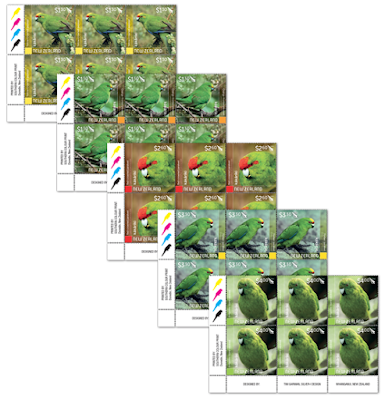In te reo Māori, the indigenous language of Aotearoa New Zealand, kākāriki is the term used to describe the small parakeets found on the mainland and surrounding islands. All species and subspecies of New Zealand parakeet share the characteristic of green plumage, and kākāriki also serves as the word for this colour.
Kākāriki are small moss green-coloured parrots with a few blue flight feathers and long tails. Each species is diagnostically different, often with bright red or yellow feathering on the forehead and crown, near the eye and on the side of the rump. Like many of New Zealand’s native birds, they are threatened by introduced mammalian predators.
The Single Stamps.
$1.30 - Yellow-crowned parakeet.
By feeding mainly on invertebrates, flowers and seeds in the canopy of beech and podocarp forests, and by nesting high up in trees, Cyanoramphus auriceps have been more resistant to the threat of mammalian predators than other species.
$1.30 - Orange-fronted parakeet.
Because they feed on invertebrates, flowers and seeds in the lower levels of the forest, Cyanoramphus malherbi are very vulnerable to predators, and so remain one of New Zealand’s most threatened birds.
$2.60 - Red-crowned parakeet
Cyanoramphus novaezelandiae have largely disappeared from the New Zealand mainland, but flourish on many islands from the subtropical Kermadec Islands to the subantarctic Auckland Islands, and many offshore islands of Aotearoa.
$3.30 - Forbes’ parakeet.
In the distant past, the ancestors of yellow-crowned parakeets reached the Chatham Islands, and slowly changed sufficiently to be recognised as a distinct species, Cyanoramphus forbesi.
$4.00 - Antipodes Islands parakeet
Although they can fly, Cyanoramphus unicolour prefer to walk and climb through vegetation. Unusually, they feed on fat from seabird carcasses, on broken eggs, and can occasionally kill small seabirds.
Covers and Miniature Sheet.
The miniature sheet and first day cover for this issue both showcase the striking red-crowned parakeet, while the first-day cover captures the Antipodes Island parakeet nibbling on a spear of grass, just one item in its varied diet.
First Day Cover - 4 March 2020.
Miniature Sheet.
Miniature Sheet First Day Cover - 4 March 2020.
Other Collectable Items.
Set of Plate Blocks. Set of Value Blocks.
Set of Full Sheets.
Presentation Pack.
You can learn more about New Zealand’s charming parakeets with the special presentation pack that came with this stamp issue. Guest writer Dr Hugh Robertson is a Fellow of the Ornithological Society of New Zealand (Birds New Zealand), and co-author of The Field Guide to the Birds of New Zealand and The Hand Guide to the Birds of New Zealand.
The pack included a set of the stamps, plus miniature sheet and First Day Cover.
Technical information.
Date of issue: 4 March 2020.
The number of stamps: Five gummed stamps.
Denominations: $1.30 x2, $2.60, $3.30, $4.00.
Stamps, miniature sheet and first day covers designed: Tim Garman, Whanganui, New Zealand.
Printer: Southern Colour Print, New Zealand.
The number of colours: Four process colours plus overgloss with special fluro colour per stamp.
Stamp size and format: 35mm x 34.55mm (vertical).
Paper type: 104g Tullis Russell Red-Phosphor gummed stamp paper.
The number of stamps per sheet: 25.
Perforation gauge: 14 x 14.
Period of sale: Unless stocks are exhausted earlier, these stamps will remain on sale until 3 March 2021. First-day covers will remain on sale until 29 April 2020.
Some of the images in this post were used with permission from the illustrated catalogue of StampsNZ
You can visit their website and Online Catalogue at, http://stampsnz.com/
Information & images for this post came from.













We appreciate your engagement with our content. To ensure a respectful and constructive community, please take note of the following:
- No Spam, Please: We do not tolerate spammy or promotional comments. Any such comments will be promptly removed.
- Moderation in Place: All comments are moderated to maintain a positive and inclusive environment. Please be patient, as it may take a little time for your comment to appear.
- Sign In with Google: To comment, please sign in using your Google account. This helps us maintain the integrity of our community and allows for better interaction.